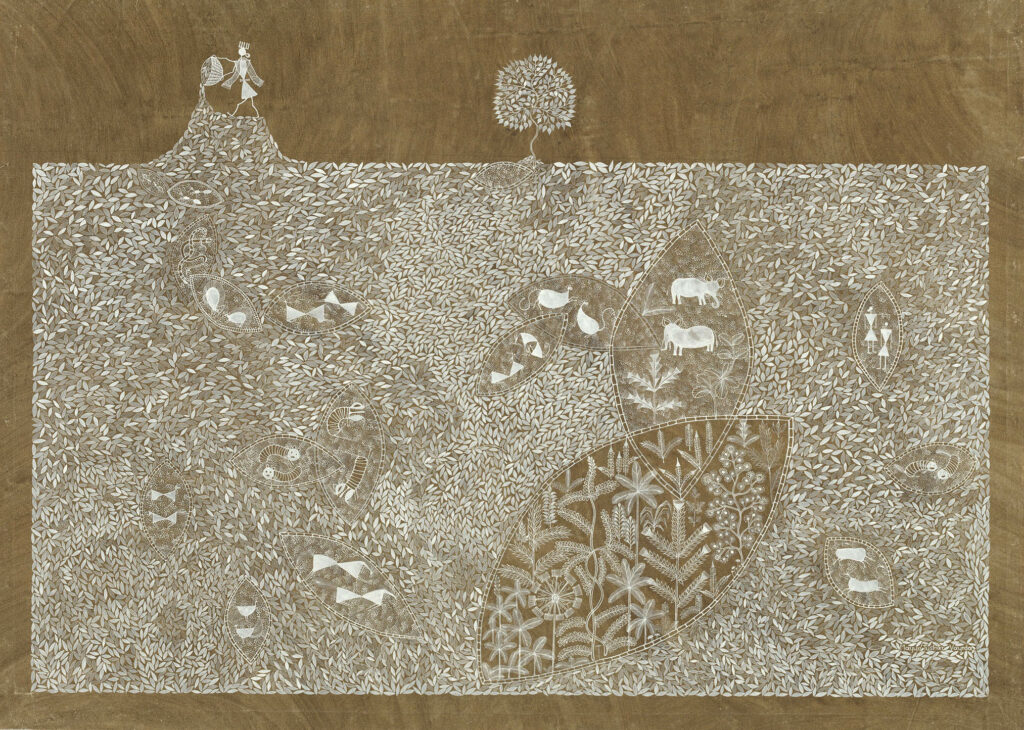
‘Kansari (Goddess of Seeds)’ by Mayur Vayeda and Tushar Vayeda, 2021 from the Sarmaya collection
The art of the Warli community, like many other indigenous Indian traditions, was always interwoven with rituals and festivals. These ritual paintings were made on hut walls by married women known as suvasini, during harvest and wedding seasons. The drawing was also a communal activity; young adults and children would make these decorative motifs alongside their mothers. Warli paintings are among the most recognisable art forms of the Subcontinent. We see them in art galleries and urban murals, as well as on everything from textiles to pottery. How did the art of a people from the mountains of western India capture the imagination of the nation and, eventually, the world?
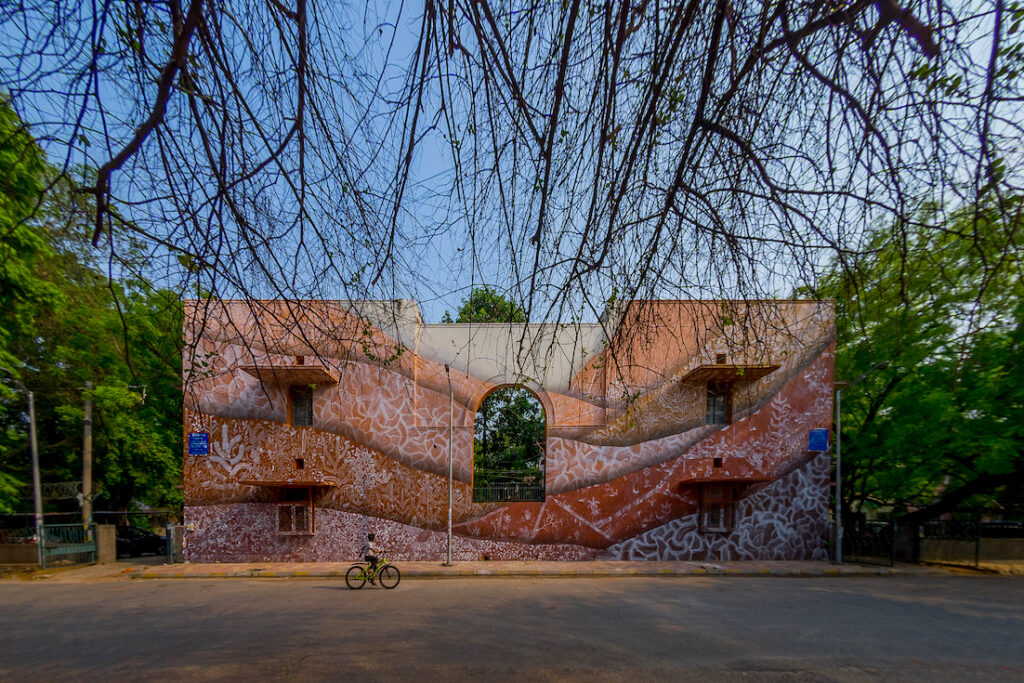
A mural by Mayur and Tushar Vayeda at Lodhi Art District, Delhi
When did Warli art begin?
Warli art was brought into India’s developing art market in the 1970s by a team of writers, theorists and artists. Guided by the vision of cultural activist Pupul Jayakar, they assisted tribal artists in transferring their skill onto paper or canvas. The effort was meant to revive dying artforms and create new sources of income for the communities that preserved them.
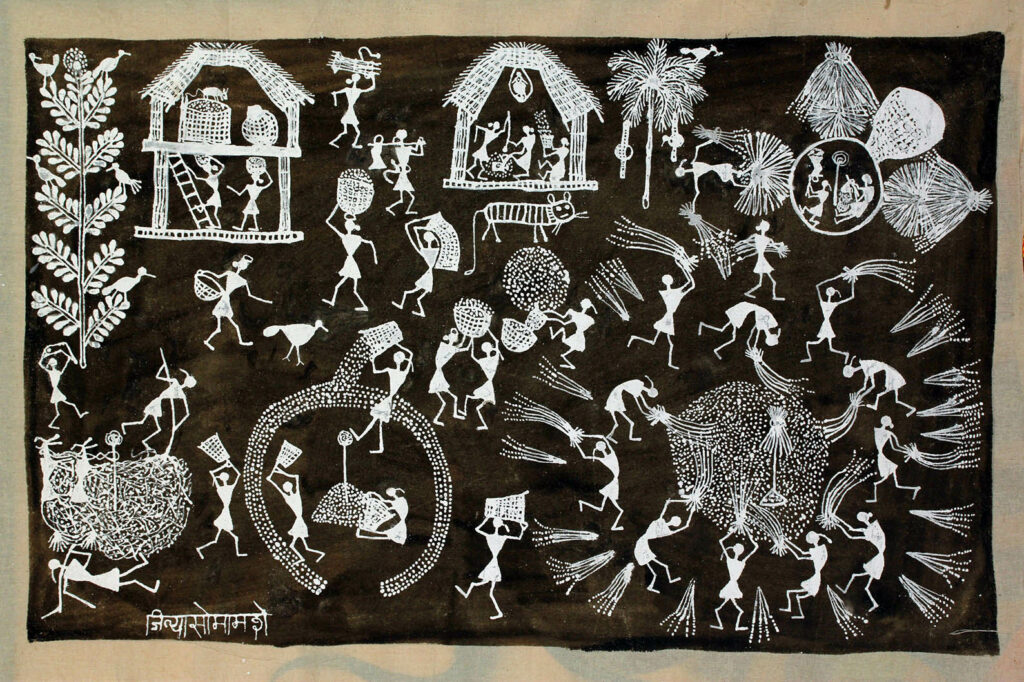
‘Threshing’ by Jivya Soma Mashe from the Sarmaya collection
Who was the first Warli artist?
Mumbai artist Bhaskar Kulkarni worked closely with the Warlis, who are natives of the northern Sahyadri region of Maharashtra and southern Gujarat. Eventually, the artists—all women—were invited to Delhi. They were accompanied by one man who had until then practised the art mainly as a hobby. This was Jivya Soma Mashe. His work stood out for departing from the traditional themes that the women painted. Soma Mashe, mentored from then on by Kulkarni, became the first Warli artist to paint on paper. In 1975, his work was exhibited at the Chemould Prescott Road gallery in Mumbai. As Pupul Jayakar was actively organising exhibitions in France, America and Japan at this time, Jivya Soma Mashe went on to make his international debut a year later at Palais de Menton, France.
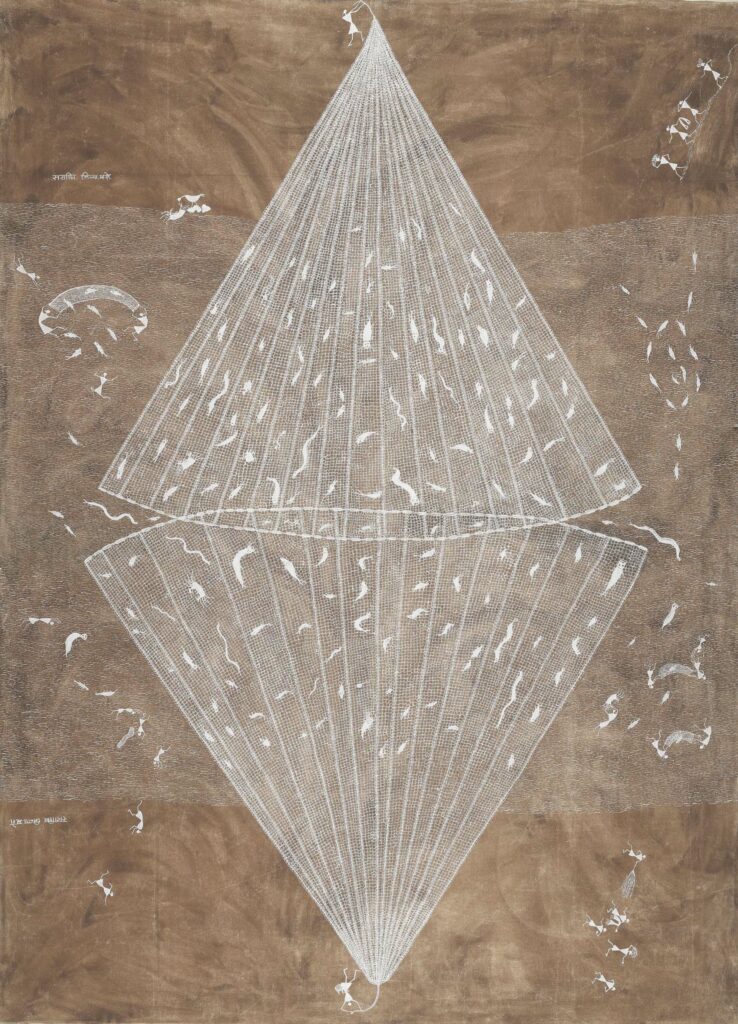
Paagir (Fishnet) by Sadashiv Jivya Mashe from the Sarmaya collection
Do only men make Warli art?
Soma Mashe began with narrative works, like those on threshing and harvesting, and later created more visually complex paintings. He collaborated with several national and international artists, travelled widely and received many awards, including the Padma Shree in 2011. He mentored artists through a training program for which he chose three girls and three boys. For reasons that haven’t been recorded, the girls did not complete the training and the art in its commercial form came to be practised overwhelmingly by male artists. More recently, Warli women have begun to reclaim this space.
What are Warli paintings about?
Today Jivya Soma Mashe’s students and son, Sadashiv Jivya Mashe, carry on the legacy through works like Paagir (Fishnet). Describing the work in an interview with Sarmaya, Sadashiv Jivya Mashe said, “This format is unique. My father first began doing this, and since then, other artists have followed suit. My father also came up with this double format at the recommendation of a buyer from Paris, who now buys from me.”
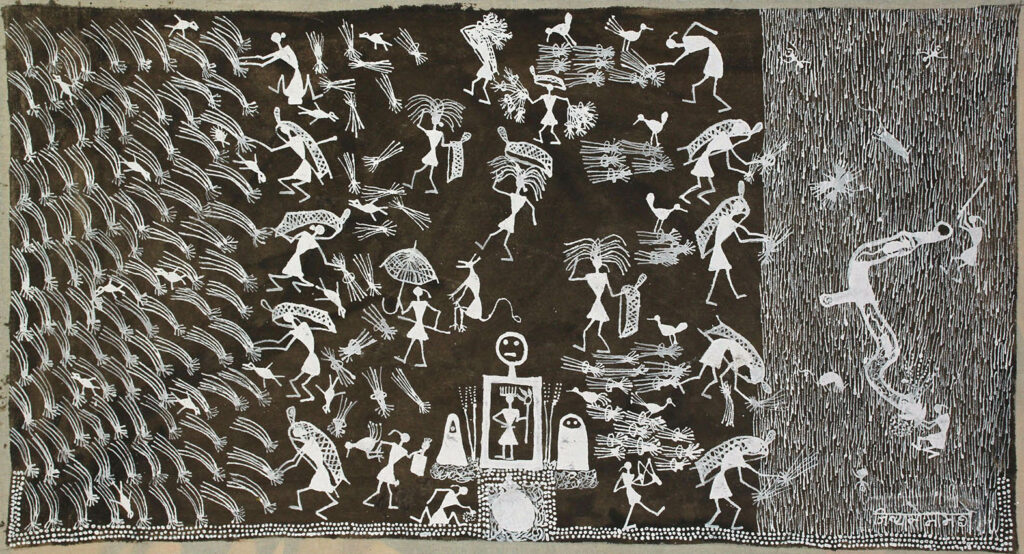
‘Harvesting’ by Jivya Soma Mashe from the Sarmaya collection
The underlying theme in most Warli paintings is the tribe’s relationship with the land and nature. Scenes of farming, harvest, fishing, festivities and weddings all are placed within the landscape of the north Konkan, complete with the region’s flora and fauna. Considered the original inhabitants of this land, the identity of the Warli people is tied with these forests. They practised shifting cultivation, moving from one forest to another, and came to inhabit a large stretch of land—from Dangs in southern Gujarat to Thane in northern Maharashtra.
What subjects does contemporary Warli art address?
Over centuries, the land of the Warlis has been steadily encroached upon, necessitating a migration to urban centres to work on farms and industrial projects as manual labourers. Families began to be able to buy small pieces of land and settle down in areas like Valsad and Surat in Gujarat and Nasik, Dhule, Thane and Mumbai in Maharashtra. Today, the Warli people living in Thane, Palghar, Dahanu and neighbouring districts are primarily rice farmers and foragers of forest produce. Its current generation of artists interpret contemporary concerns through the lens of mythology and native wisdom. Artists like brothers Mayur and Tushar Vayeda use Warli art to talk about threats to their homeland and the planet.
When Warli art was promoted by the government in the ’70s, it was guided by the interests of the art market and the aesthetics of non-tribal mentors. Today, artists have redefined the medium to share their lived experiences. They are returning to the art its ritual aspects and oral narratives, which are as intrinsic to the form as style. At our 2022 exhibition Echoes of the Land – Art bears witness to a changing planet, Mayur Vayeda created a grain installation to demonstrate the annual harvest ritual of khala performed by the community. Khala is a ceremony of thanksgiving offered to Goddess Kansari, the keeper of seeds and bestower of fertility.
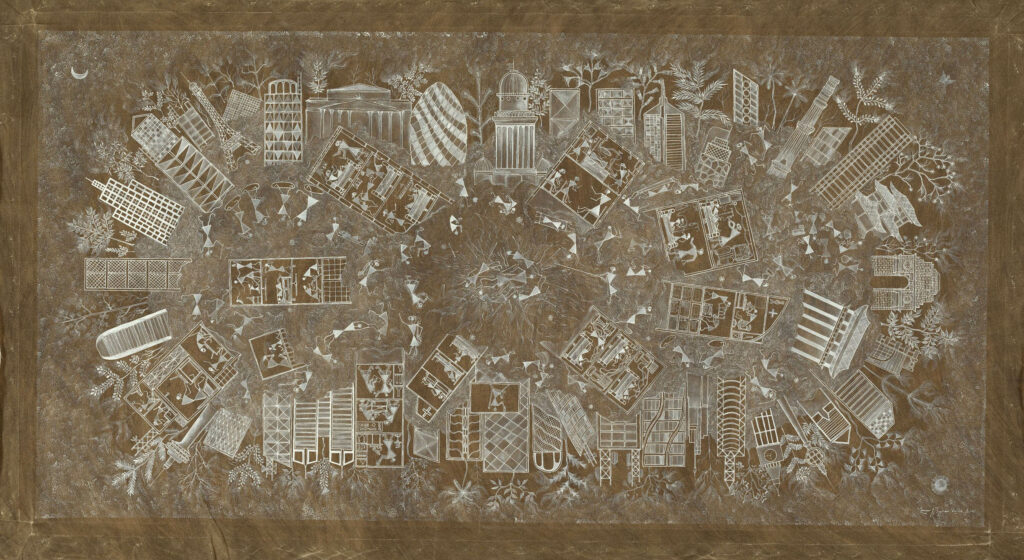
‘The Wave’ by Mayur Vayeda and Tushar Vayeda, 2021 from the Sarmaya collection
In The Wave, the artists place contemporary issues like the COVID-19 pandemic and climate emergencies within the context of Warli mythology. In a conversation with Sarmaya, Mayur Vayeda said, “This painting was created during the lockdown and depicts not just COVID but the different waves that humans are facing. We’ve always believed we have to take care of the earth but [the pandemic showed] that we do not need to be its custodians. We just need to stop [causing harm], so that nature can recover. Corona was something that came from nature to bring balance to the planet. During the lockdown, we saw birds and animals that had disappeared from the community come back.”
The artists have taken inspiration for Wave from the creation myth of the Warli people. As Mayur explained, “In the centre of the painting, there is a pit in which people are burning. In the story of creation, originally there was only birth on the planet, no death. Over-burdened, the earth cried out, asking the Creator for help. That’s when death was created and God made it so that the dead return their energy to Mother Earth, Dhartari.”
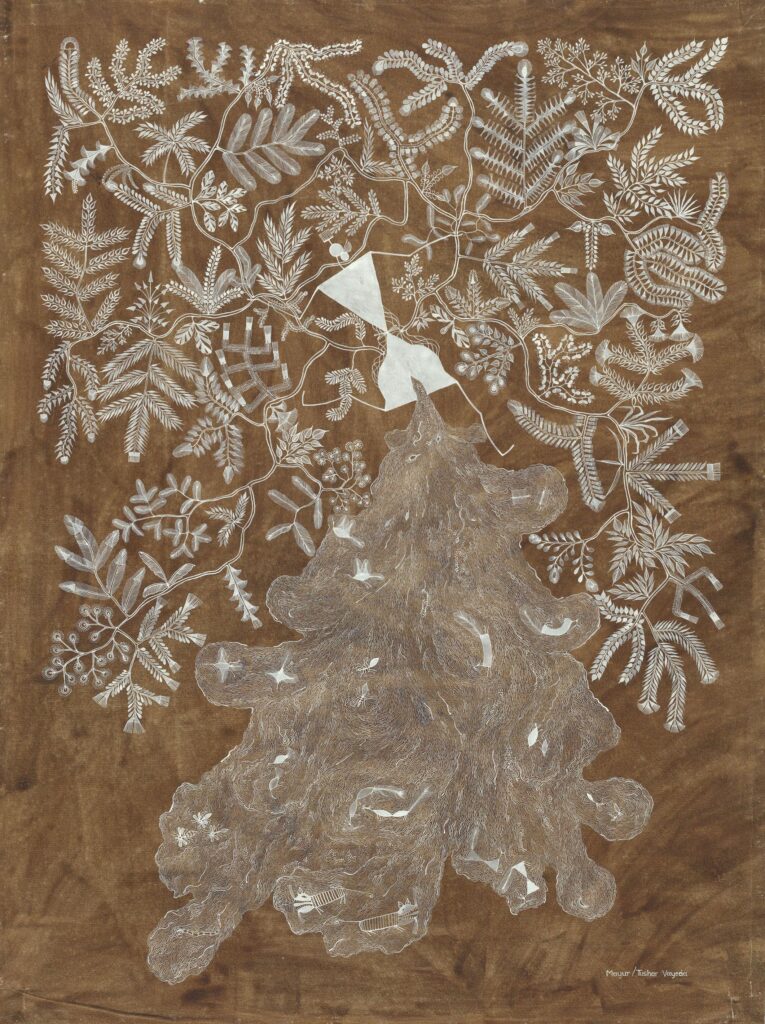
‘Birth’ by Mayur Vayeda and Tushar Vayeda, 2021 from the Sarmaya collection
References
- Yashodhara Dalmia, The Painted World of the Warlis: Art and Ritual of the Warli tribes of Maharashtra, (New Delhi, Lalit Kala Academy, 2008)
- Warli Painting by Mushtak Khan – Sahapedia, last modified on November 20, 2018
- Jivya Soma Mashe, MAP Academy, modifications 2021
- Jaya Wathare, Mumbai’s ‘The Warli Revolt’: Swadesi voicing the concerns of the Tribals, September 21, 2021



